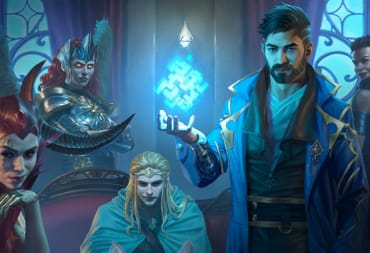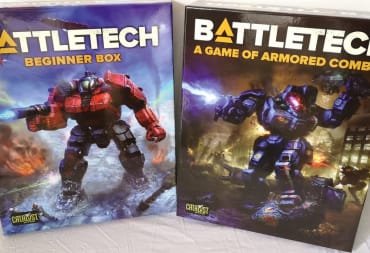BattleTech has a huge history in terms of tabletop gaming and video games. Starting life on the tabletop in 1984 as a wargame, it has been transferred across nearly every tabletop market including board games, a collectible card game, roleplaying games and a collectible miniatures game. The franchise has also seen over twenty different video games since the first in 1988. Most of the previous games have been first-person mech games, but now Harebrained Schemes and Paradox Interactive are taking BattleTech back to its tabletop roots with an extremely in-depth turn based tactical strategy game.
For anyone interested in the History of BattleTech, we have our own introduction to the setting.

The BattleTech universe has a long running and active in-game history that has been developed over the lifespan of the franchise. A knowledge of this history isn't required though, as this incarnation takes BattleTech back to the end of the Succession Wars, near the start of the in-game history, and does a great job of bringing you into the setting. The Succession Wars started just after a coup, in which the leader of the Star League, an organization that united the five Great Houses of the Inner Sphere, was killed. After the coup was defeated, the Great Houses took the known galaxy into a civil war, as each wanted to be the next leader of the Star League . BattleTech begins towards the end of this era. In the game, you are a MechWarrior, a pilot of a huge armored robot weapons platform known as a Mech. There are a huge variety of Mechs, each offering different abilities, armaments options, and characteristics.

The game begins with you creating your character and picking your history, which sets up your in-game stats, much like an RPG and also can give you in-game conversation options in certain situations. You then create the look of your character and name them. If you're not familiar with the setting, just read through the options and pick what appeals to you; previous players will already have an idea of the background they want for their character and the options given are great for BattleTech fans. After creating your character, you head into the tutorials.
BattleTech is a game of two halves: in-game battles and out of battle management. The initial tutorials cover the basics of movement, combat, and some of the in-game mechanics like over-heating and range, but the sheer depth of the game is left to you to work out and experiment with between Mech setups and in-game experience.

Battles can be straight-forward affairs of your just throwing your Mechs towards the enemy and shooting any that come towards you, but every piece of damage your Mech takes has to be paid for in repairs, which decreases the money you will earn for each job. So learning the different ranges, using evasion, and positioning your Mechs to hit opposing Mechs in their more vulnerable rear becomes a priority. That's what pushes BattleTech on and makes each battle an interesting and extremely tactical challenge, as every move should be considered properly and poor judgement can leave you eventually bankrupt or your best MechWarriors out of action for a length of time.
The battle phases allows you to take four Mechs into combat, which breaks down into a series of turns that are split into five initiative order phases to decide who acts first. Lightly armored, less-armed Mechs generally go first, with the slower heavily armed Mechs going last. This allows you to try to bring down, or at least damage, some of the weapon systems of larger Mechs before they can unleash them. The fog of war means that you'll need to send lighter Mechs forward to scout and find enemies, using the evasion system that allows Mechs to dodge attacks rather than ride them out on their armor to avoid damage.
The huge variety of different weapons that will be familiar to previous MechWarrior fans or BattleTech tabletop players, all have different damage ratings and abilities. Lasers heat up your Mech but can do a steady amount of damage over a decent range, where as support weapons like machine guns and flamers might not do so much damage but can be used after melee attacks and also have a better chance of hitting evading mechs at close range.

On each turn, your MechWarriors get a variety of options, and learning to make best use of them is what drives each battle. You are able to see the attack options for the active Mech, from each of its available movement options, and the UI will display the hit percentage for each weapon from that location. Available options to some MechWarriors are multi-shot and precision shot. Multi-shot allows you to target multiple opponents and strip evasion off them in order to attack with more powerful weapons later, or simply because attacking one target with everything would be overkill. Precision shot allows you to aim for a particular part of the enemy Mech, either to attack a part that's already been damaged or to take out a powerful weapon on that body part. Mechs can be taken out by destroying the legs, incapacitating the pilot by doing damage to certain parts, or taking it out altogether by destroying the head or central torso.
In the first few battles, you won't be overwhelmed by enemy Mechs. You will find them in groups of one to three supported by vehicles that are simple to take out but can be extremely damaging if you don't deal with them. The in-game AI will target your weaknesses; for example, in the first mission after the tutorial, if you range ahead with your light Mech and it gets damaged, the enemy will bombard it to take it out, even if it's supported by other Mechs. Or if a part of your Mech is heavily damaged, or a flank or rear is exposed, they will capitalize on this. You will of course be able to gang up on smaller groups of Mechs and destroy them with superior firepower, but as the game progresses and things start to even out in terms of numbers, aiming for precision shots at dedicated targets, baiting the enemy, and making sure your weaknesses are exposed will make or break your battles.
There is a distinct learning curve with the UI and no difficulty setting. Getting to know what everything means and does, as well as all your available options will take some time, and I imagine that a few players will restart their story mode after playing the first few battles, as they will be better prepared to attempt it again once they have a greater understanding.

BattleTech's story mode takes you through a space adventure, where you try to recapture the throne for an ousted leader by building up your own forces and waging war. This is done by taking on missions to build up your funds and travelling to different planets to find contracts, hire MechWarriors, and build up your available Mechs.
You can take on as much of BattleTech's setting as you want. Cut scenes, while not cutting edge graphics, are animated well and really drive the theme. You can chat to other members of the crew to build up your knowledge, and hover over dialogue options allow you to read more into the history of the setting. The voice acting and dialogue are solid, and perfectly in keeping with the setting.
Outside of battles, you have to decide how best to manage your crew, Mechs, and equipment that you build up over time. Finding and arming Mechs to suit your style and picking the missions you are entering means that management becomes as key as avoiding taking huge amounts of damage in a battle. If you're familiar with BattleTech and the weapons and equipment, most of the in-game management will be very straight forward to you. However, those experiencing BattleTech for the first time will have to take some time learning weapons combinations on Mechs, equipment, and weapon placement, as well as different Mech combinations in the four you take into battle that complement each other. Learning all that can take some time and will build up with experience, but don't let that put you off as it's worth the effort.
In terms of management, expanding your crew is a balancing act with your finances. Every month there is a financial report that takes out the running costs of your Mechs that aren't in storage as well as your MechWarriors' wage, as well as the repairs and upgrade costs of Mechs. After each battle, as well as the agreed sum for the mission, you also get salvage, which usually gives a better return than the fee for the mission. Managing your stores, collecting Mech scraps to build new Mechs, and buying ammo will become second nature after a few cycles, as well as the ability to know which Mech load-outs will work in what environment.
With BattleTech multiplayer, I’d hoped that it would be an exact replica of the tabletop battles I’d had with my friends when I first started playing BattleTech. While it doesn’t quite capture the unique tabletop flavor, it is a satisfying multiplayer experience, when played with friends. Currently, BattleTech multiplayer is a versus battle set up through hosted games, which is perfect when you’ve arranged a game with friends, but without a matchmaking service, you can sit in your host room without a game for a while. The other noticeable issue is that without any kind of multiplayer leveling up or rank/reward system, if you do a sizable amount of damage early on to an opponent, they simply quit the game, leaving you to start again and search for another opponent. Both of these issues mar what could be a great multiplayer experience.
Multiplayer battles themselves consist of picking any Mech combinations you want, within the weight limit of the game. BattleTech has some pre-loaded loadout for the most common weight categories, but in the Mech Bay you can fit, equip, and color your Mechs how you see fit, before taking them head to head against your opponents. Multiplayer battles play out similar to the skirmishes in the singleplayer campaign, with you trying to bait and sensor-lock your opponents before drawing them into range and opening up with your whole squad’s arsenal. It’s a rewarding experience, when playing against friends or opponents who get past the initial first attack hurdles.
For fans of BattleTech, there is much to love here in terms of conversion from tabletop to video game, with the setting and mechanics done extremely well. For those new to the setting, you will find a deep immersive experience in terms of turn-based strategy and after-battle management with enough roleplaying elements and challenge to keep it interesting. Fans of real-time strategy and first person shooters might find BattleTech slow but shouldn't let that put them off, as BattleTech is a great and rewarding game, as well as an incredible introduction to the BattleTech setting.
This copy of BattleTech was reviewed on PC with a copy that was provided by the publisher. It is available on Steam and GOG.
Review Summary
Pros
- Great turn-based gameplay
- Familiar Mechs and weapons are done well
- Great introduction to the setting for new players
- In-depth options through battle management
Cons
- UI can be overwhelming to beginners
- A lot to take in after the tutorials
Have a tip, or want to point out something we missed? Leave a Comment or e-mail us at tips@techraptor.net













